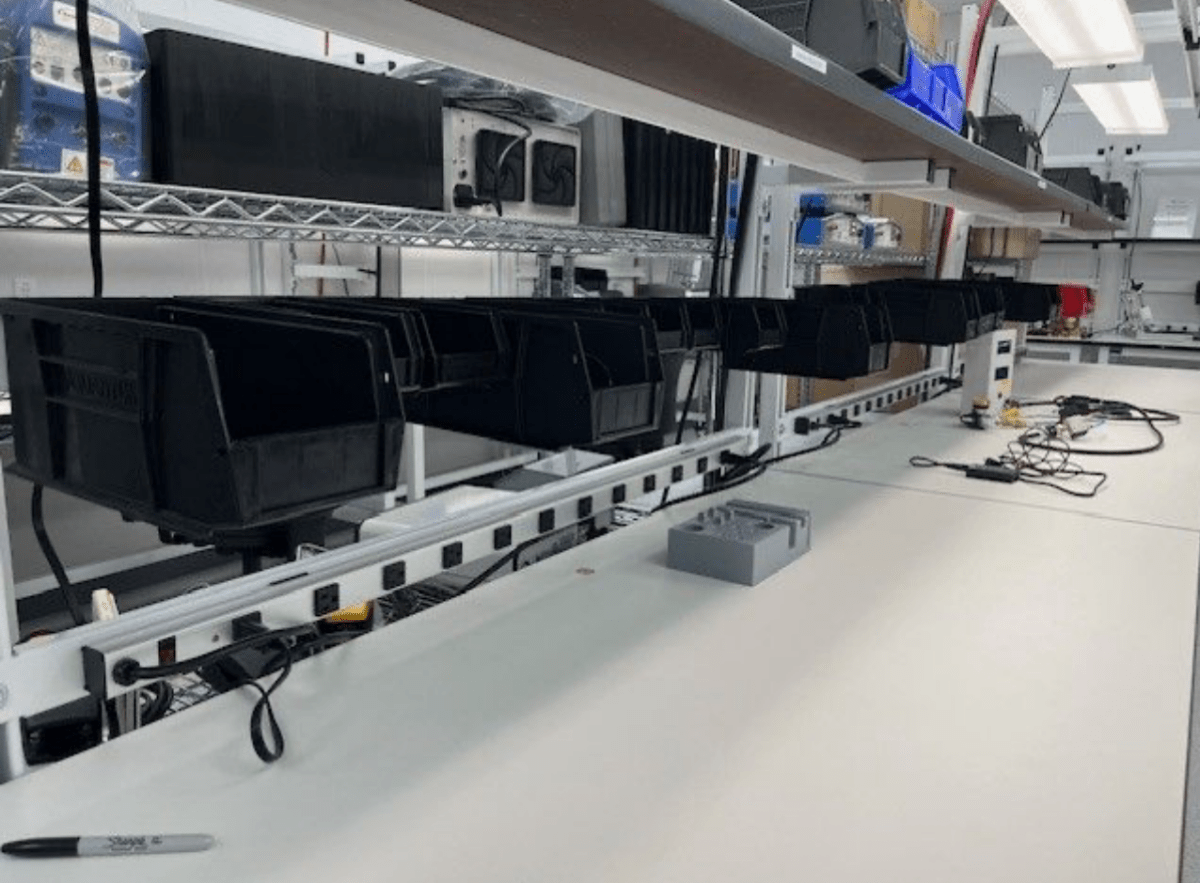Static electricity is an invisible threat to modern electronics. A single discharge can punch through nanometre‑scale gates, corrupt medical sensors, or scramble avionics boards. That’s why serious electronics operations establish an ESD‑protected area (EPA) that keeps every component, tool, and person safely grounded.
The setup in the photo, carbon‑filled esd-safe stacking and hanging bins on a grounded rail, a clean laminate work surface with an integrated power raceway, adjustable shelving, and bright LED lighting, ticks every EPA box while adding the flexibility that high‑mix work demands.

ESD Safe Bins Applications & Layout Examples
SMT Production & Re‑Work Cells
-
Typical tasks
- Kitting reels of 0402 passives, QFPs, and sockets
- Swapping feeder carts and stencils between jobs
-
Touch‑up soldering, BGA reballing, and final inspection
-
Why this layout excels
- Conductive bins remain part of the ground path, so parts stay protected from the moment they leave moisture‑barrier bags.
- A single horizontal rail keeps components inches from pick points, cutting line‑changeover time to seconds.
-
The integrated power raceway eliminates extension‑cord clutter, improving safety and freeing up floor space.
Medical Device & Aerospace Assembly
-
Typical tasks
- Final assembly of implantable sensors, infusion pumps, or cockpit LRUs
- Serial‑number capture and lot‑code traceability
- 100 % visual and functional inspection under bright task lighting
-
Why this layout excels
- Grounded shelving, dissipative work surfaces, and conductive bins satisfy FDA and FAA audit requirements.
- Carbon‑black bins are pigment‑free and suitable for cleanroom environments.
-
Rails, lights, and shelves reposition easily, so lines can pivot from heart‑rate monitors to aerospace control units without new furniture.
Depot Repair & Refurbishment Centers
-
Typical tasks
- Board‑level repair of servers, telecom gear, or handheld scanners
- Component‑level troubleshooting and replacement
-
Firmware reflash and functional test before return to service
-
Why this layout excels
- Hanging bins ride a single rail across multiple benches, enabling true FIFO parts flow.
- “Hovering” storage keeps the bench clear for microscopes, hot‑air stations, and oscilloscopes.
-
Rails unbolt in minutes, so you can drop in an extra test fixture without slowing throughput.
R&D Labs and Contract Box‑Build Lines
-
Prototype labs shuffle projects fast. One week the bins hold Raspberry Pi hats; the next, lidar boards and 21700 cells.
-
Box‑build assemblers stage screws, fans, and harnesses directly above the chassis‑build area, so operators never hunt for hardware.
Key Take‑Home Features
-
Conductive hang‑and‑stack bins — Surface resistance in the 10³–10⁵ Ω range drains static safely to ground.
-
Grounded steel rail — Bonds every bin to the same potential as the bench, satisfying equipotential‑bonding requirements.
-
Integrated power raceway — Fused outlets every few inches mean no daisy‑chained power strips.
-
Modular uprights and shelves — Accept monitor arms, vision cameras, or UV lamps without drilling or welding.
-
Wire reel carts — Store full reels and packaging materials within the EPA yet off the primary work surface.
Ready to Equip Your Line?
Industrial 4 Less stocks every element shown—from the conductive bins and louvered rails to complete ESD workstations—so you can stand up a compliant, future‑proof line without custom fabrication delays.
Have questions? Reach out and we’ll configure the exact kit your process needs.


